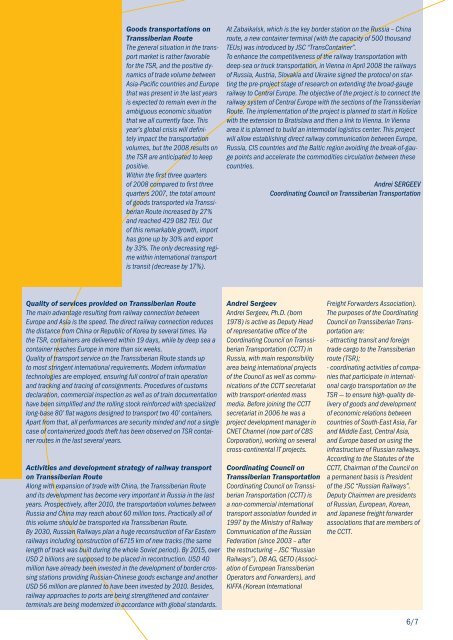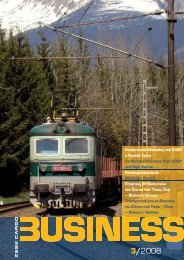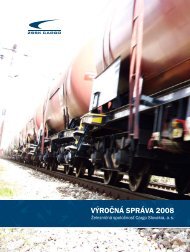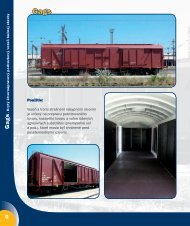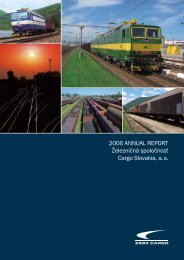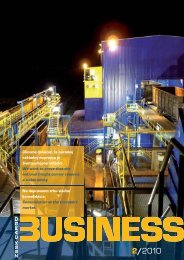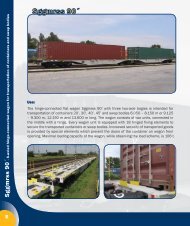CARGO BUSINESS 1-09.indd - ZSSK Cargo
CARGO BUSINESS 1-09.indd - ZSSK Cargo
CARGO BUSINESS 1-09.indd - ZSSK Cargo
- No tags were found...
You also want an ePaper? Increase the reach of your titles
YUMPU automatically turns print PDFs into web optimized ePapers that Google loves.
Goods transportations onTranssiberian RouteThe general situation in the transportmarket is rather favorablefor the TSR, and the positive dynamicsof trade volume betweenAsia-Pacific countries and Europethat was present in the last yearsis expected to remain even in theambiguous economic situationthat we all currently face. Thisyear’s global crisis will definitelyimpact the transportationvolumes, but the 2008 results onthe TSR are anticipated to keeppositive.Within the first three quartersof 2008 compared to first threequarters 2007, the total amountof goods transported via TranssiberianRoute increased by 27%and reached 429 082 TEU. Outof this remarkable growth, importhas gone up by 30% and exportby 33%. The only decreasing regimewithin international transportis transit (decrease by 17%).At Zabaikalsk, which is the key border station on the Russia – Chinaroute, a new container terminal (with the capacity of 500 thousandTEUs) was introduced by JSC “TransContainer”.To enhance the competitiveness of the railway transportation withdeep-sea or truck transportation, in Vienna in April 2008 the railwaysof Russia, Austria, Slovakia and Ukraine signed the protocol on startingthe pre-project stage of research on extending the broad-gaugerailway to Central Europe. The objective of the project is to connect therailway system of Central Europe with the sections of the TranssiberianRoute. The implementation of the project is planned to start in Košicewith the extension to Bratislava and then a link to Vienna. In Viennaarea it is planned to build an intermodal logistics center. This projectwill allow establishing direct railway communication between Europe,Russia, CIS countries and the Baltic region avoiding the break-of-gaugepoints and accelerate the commodities circulation between thesecountries.Andrei SERGEEVCoordinating Council on Transsiberian TransportationQuality of services provided on Transsiberian RouteThe main advantage resulting from railway connection betweenEurope and Asia is the speed. The direct railway connection reducesthe distance from China or Republic of Korea by several times. Viathe TSR, containers are delivered within 19 days, while by deep sea acontainer reaches Europe in more than six weeks.Quality of transport service on the Transsiberian Route stands upto most stringent international requirements. Modern informationtechnologies are employed, ensuring full control of train operationand tracking and tracing of consignments. Procedures of customsdeclaration, commercial inspection as well as of train documentationhave been simplified and the rolling stock reinforced with specializedlong-base 80’ flat wagons designed to transport two 40’ containers.Apart from that, all performances are security minded and not a singlecase of containerized goods theft has been observed on TSR containerroutes in the last several years.Activities and development strategy of railway transporton Transsiberian RouteAlong with expansion of trade with China, the Transsiberian Routeand its development has become very important in Russia in the lastyears. Prospectively, after 2010, the transportation volumes betweenRussia and China may reach about 60 million tons. Practically all ofthis volume should be transported via Transsiberian Route.By 2030, Russian Railways plan a huge reconstruction of Far Easternrailways including construction of 6715 km of new tracks (the samelength of track was built during the whole Soviet period). By 2015, overUSD 2 billions are supposed to be placed in recontruction. USD 40million have already been invested in the development of border crossingstations providing Russian-Chinese goods exchange and anotherUSD 56 million are planned to have been invested by 2010. Besides,railway approaches to ports are being strengthened and containerterminals are being modernized in accordance with global standards.Andrei SergeevAndrei Sergeev, Ph.D. (born1978) is active as Deputy Headof representative office of theCoordinating Council on TranssiberianTransportation (CCTT) inRussia, with main responsibilityarea being international projectsof the Council as well as communicationsof the CCTT secretariatwith transport-oriented massmedia. Before joining the CCTTsecretariat in 2006 he was aproject development manager inCNET Channel (now part of CBSCorporation), working on severalcross-continental IT projects.Coordinating Council onTranssiberian TransportationCoordinating Council on TranssiberianTransportation (CCTT) isa non-commercial internationaltransport association founded in1997 by the Ministry of RailwayCommunication of the RussianFederation (since 2003 – afterthe restructuring – JSC “RussianRailways”), DB AG, GETO (Associationof European TranssiberianOperators and Forwarders), andKIFFA (Korean InternationalFreight Forwarders Association).The purposes of the CoordinatingCouncil on Transsiberian Transportationare:- attracting transit and foreigntrade cargo to the Transsiberianroute (TSR);- coordinating activities of companiesthat participate in internationalcargo transportation on theTSR — to ensure high-quality deliveryof goods and developmentof economic relations betweencountries of South-East Asia, Farand Middle East, Central Asia,and Europe based on using theinfrastructure of Russian railways.According to the Statutes of theCCTT, Chairman of the Council ona permanent basis is Presidentof the JSC “Russian Railways”.Deputy Chairmen are presidentsof Russian, European, Korean,and Japanese freight forwarderassociations that are members ofthe CCTT.6/7


